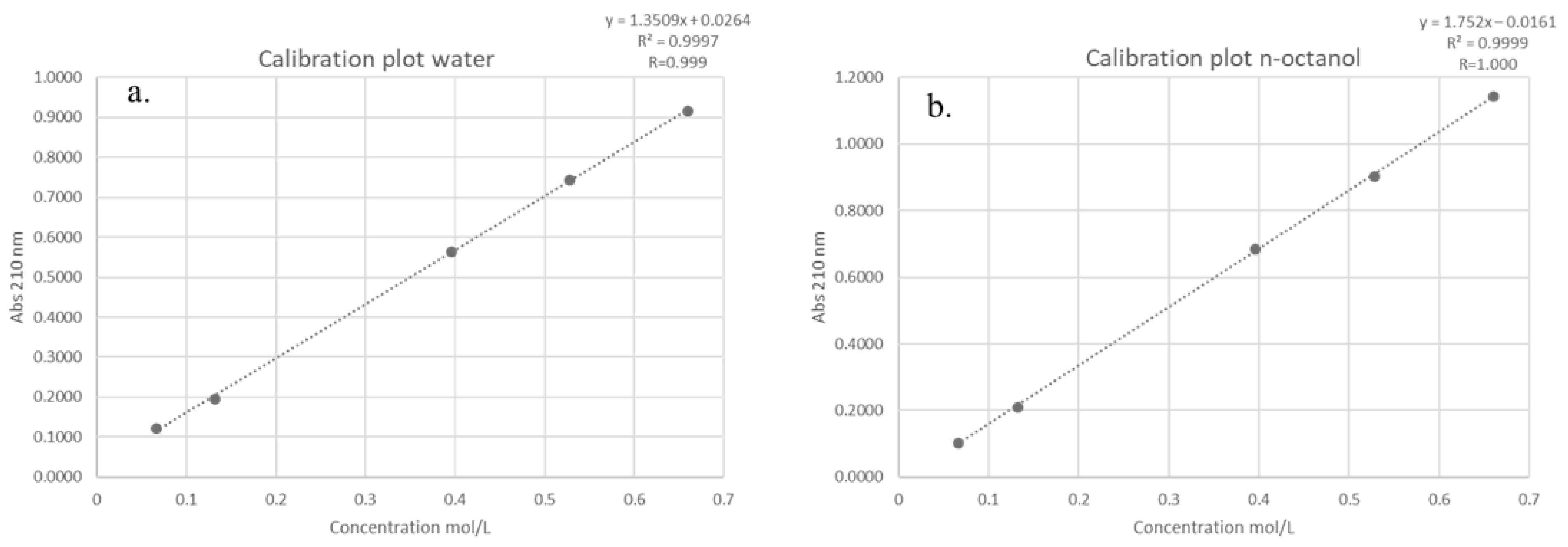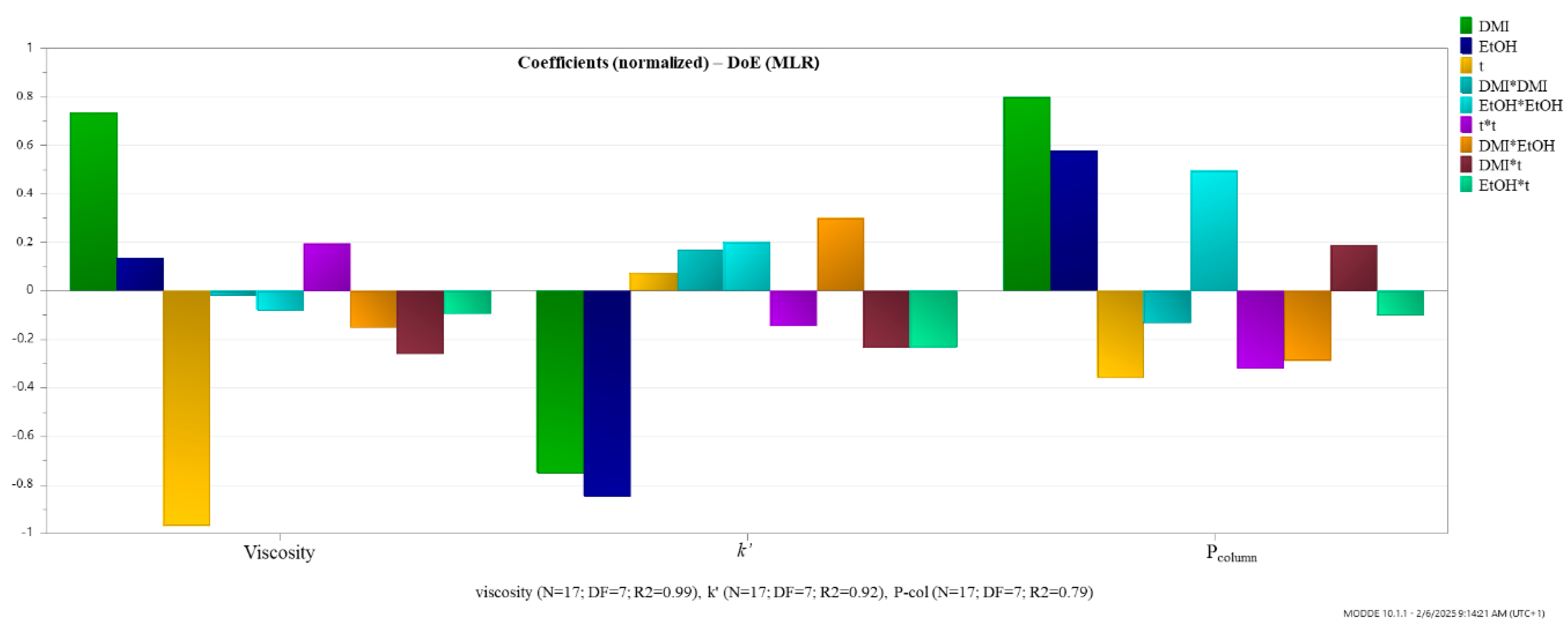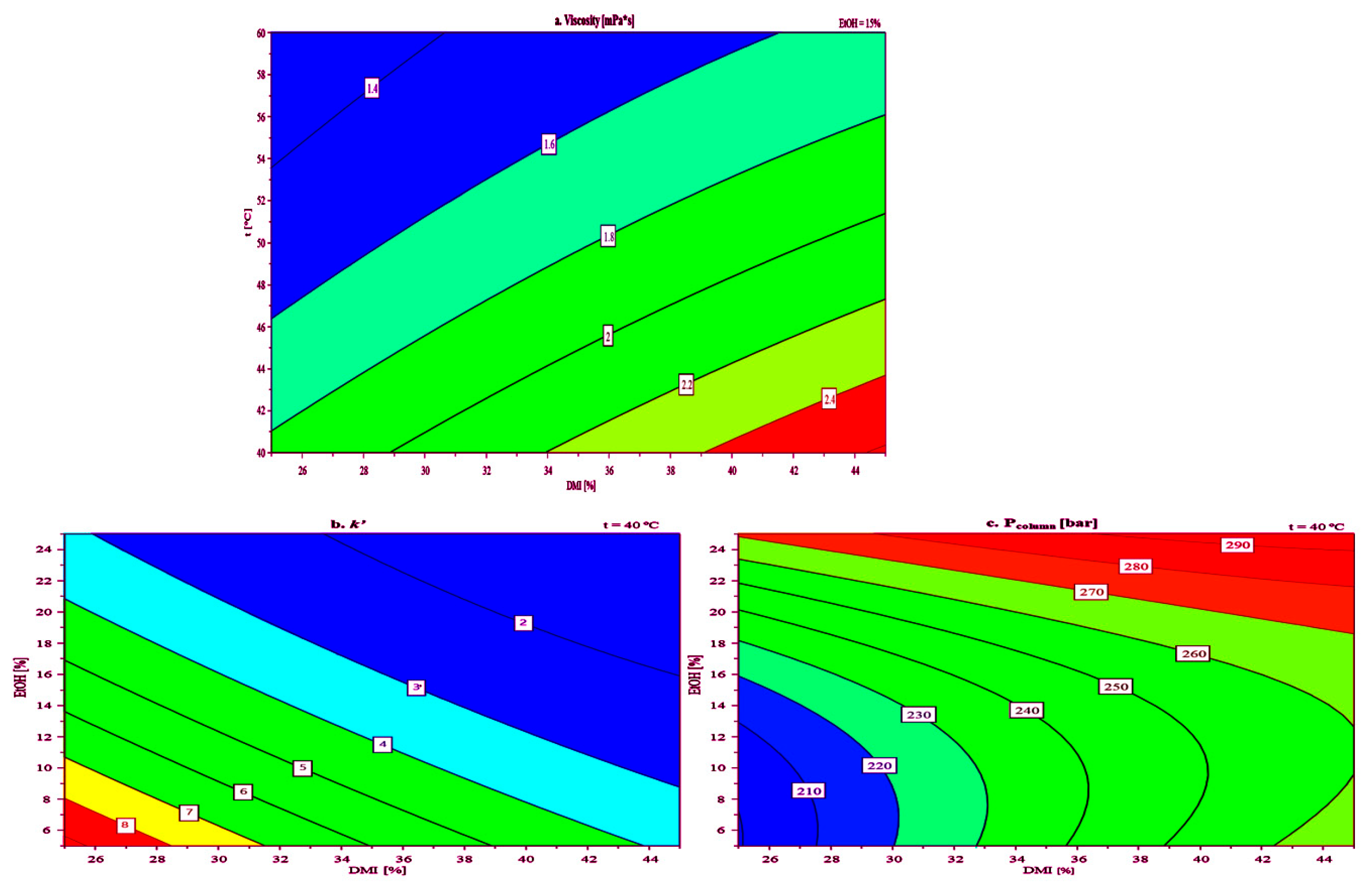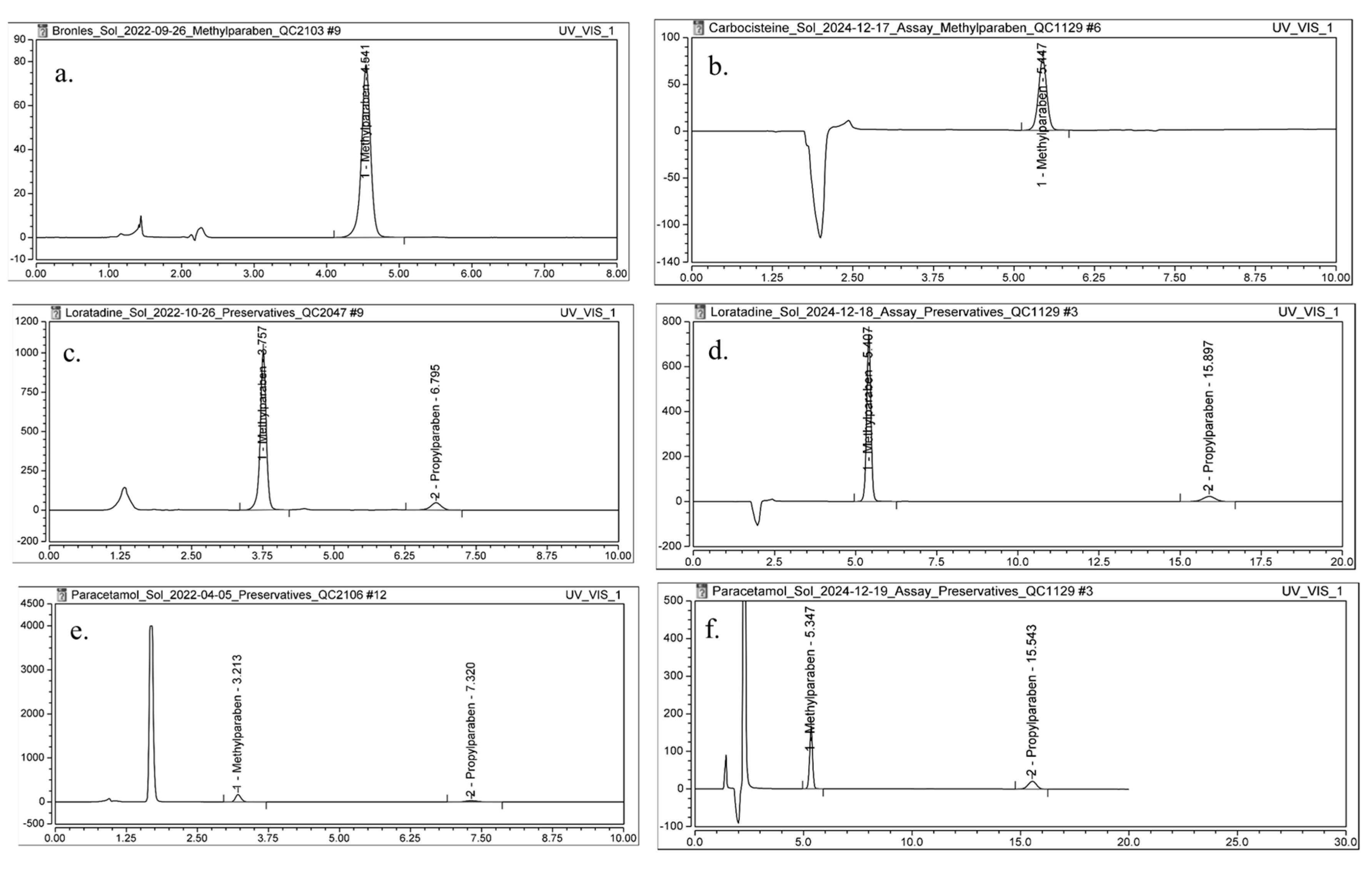Dimethyl Isosorbide: An Innovative Bio-Renewable Solvent for Sustainable Chromatographic Applications
Abstract
1. Introduction
2. Results and Discussion
2.1. Evaluation of DMI According to CHEM21 and SDS Lists

| Property | DMI | H2O | EtOH | MeOH |
|---|---|---|---|---|
| Appearance | Clear, colorless liquid | Clear, colorless liquid | Clear, colorless liquid | Clear, colorless liquid |
| Odor | No significant odor | No data available | Characteristic | Characteristic |
| Odor threshold | No data available | No data available | No data available | No data available |
| pH | No data available | 6.0–8.0 at 25 °C | 7.0 at 10 g/L at 20 °C | No data available |
| Melting point/Freezing point | −84 °C | 0.0 °C | −114.0 °C | −97.8 °C |
| Boiling point | 240 °C | 100.0 °C | 78.29 °C | 64.7 °C |
| Flash point | 116 °C | Not applicable | 13 °C | 9.7 °C |
| Viscosity | 6.62 mPa·s at 25 °C (range: 9.47 at 15 °C to 2.19 at 70 °C) [22] | No data available | 1.2 mPa·s at 20 °C | 0.544–<0.59 mPa·s at 25 °C |
| Water solubility | 2000 g/L at 20 °C | Completely miscible | 1000 g/L at 20 °C | 1000 g/L at 20 °C |
| Vapor pressure | 0.073000 mmHg (0.0973 hPa) at 25 °C. (est) [30] | No data available | 57.26 hPa at 19.6 °C | 169.27 hPa at 25 °C |
| Vapor density | No data available | No data available | No data available | 1.11 |
| Density | 1.166 g/cm3 at 20 °C | 1.000 g/cm3 at 3.98 °C | 0.79 g/cm3 at 20 °C | 0.79 g/cm3 at 20 °C |
| Partition coefficient (log P) | −0.423 (est) [30] | −0.467 | −0.35 | −0.77 |
| Autoignition temperature | 285 °C | No data available | 363–425 °C | 455.0 °C |
| Decomposition temperature | No data available | No data available | Distillable at normal pressure | Distillable at normal pressure |
2.2. Investigation of Miscibility of DMI with Water
2.3. Investigation of the Viscosity of DMI and Its Mixtures with H2O and EtOH
2.4. Determination of the UV Cut-Off of DMI and Its Implications for Chromatographic Use
2.5. Determination of the Partition Coefficient (logP) of DMI
2.6. Investigation of the Chromatographic Behavior of DMI Using Central Composite Face 23 Experimental Design
2.7. Investigation of the Applicability of DMI as an Eluent in Chromatographic Analyses
3. Materials and Methods
3.1. Model Compounds and Reagents
3.2. Experimental Setup and Equipment Used
3.3. Selection Methodology
3.4. Miscibility Experiments
3.5. Viscosity Measurements
3.6. UV Cut-Off Determination
3.7. Partition Coefficient Determination
3.8. Design of Experiments (DoE) for Investigation of the Chromatographic Behavior of DMI
3.9. Conventional Method and Method Using DMI as an Eluent in the LC Mobile Phase for Determining Preservative Content in Carbocysteine, Loratadine, and Paracetamol Oral Solutions
3.10. Preparation of Standard Solutions and Test Solutions for the Determination of MPHB and PPHB in Oral Solutions
3.10.1. Carbocisteine Oral Solution 250 mg/5 mL
3.10.2. Paracetamol Oral Solution 120 mg/5 mL
3.10.3. Loratadine Oral Solution 1 mg/mL
4. Conclusions
Author Contributions
Funding
Institutional Review Board Statement
Informed Consent Statement
Data Availability Statement
Acknowledgments
Conflicts of Interest
Abbreviations
| ACN | Acetonitrile |
| ACS | American Chemical Society |
| As | Asymmetry Factor (Peak Symmetry) |
| C18 | Octadecylsilane-bonded Stationary Phase |
| CCF | Central Composite Face |
| CHEM21 | Chemical 21st Century (Sustainable Chemistry Initiative) |
| °C | Degrees Celsius |
| DMI | Dimethyl Isosorbide |
| DoE | Design of Experiments |
| EP/Ph Eur | European Pharmacopoeia |
| est | Estimated |
| EtOH | Ethanol |
| GAC | Green Analytical Chemistry |
| GSK | GlaxoSmithKline |
| H2O | Water |
| HPLC | High-performance Liquid Chromatography |
| ISO | International Organization for Standardization |
| k′ | Retention Factor (Capacity Factor) |
| L/mol·cm | Liters per Mole per Centimeter (Unit for Molar Absorption Coefficient) |
| LC | Liquid Chromatography |
| log P | Partition Coefficient (Logarithmic Scale) |
| MeOH | Methanol |
| mol/L | Moles per Liter (Concentration Unit) |
| MPHB | Methylparahydroxybenzoate/Methylparaben |
| mPa·s | Millipascal Second (Unit of Viscosity) |
| N | Number of Theoretical Plates |
| nm | Nanometers (Wavelength Unit) |
| OECD | Organisation for Economic Co-operation and Development |
| Pcolumn | Column Backpressure |
| PPHB | Propylparahydroxybenzoate/Propylparaben |
| RC | Regenerated Cellulose |
| RP-HPLC | Reverse-Phase High-Performance Liquid Chromatography |
| R | Correlation Coefficient |
| RS | Reference Standard |
| Rt | Retention Time |
| SDS | Safety Data Sheet |
| UV | Ultraviolet |
| UHPLC | Ultra-High-Performance Liquid Chromatography |
| v/v | Volume/Volume ratio |
| VOC | Volatile Organic Compound |
References
- Pena-Pereira, F.; Kloskowski, A.; Namieśnik, J. Perspectives on the Replacement of Harmful Organic Solvents in Analytical Methodologies: A Framework toward the Implementation of a Generation of Eco-Friendly Alternatives. Green Chem. 2015, 17, 3687–3705. [Google Scholar] [CrossRef]
- Joshi, D.R.; Adhikari, N. An Overview on Common Organic Solvents and Their Toxicity. J. Pharm. Res. Int. 2019, 28, 1–18. [Google Scholar] [CrossRef]
- Li, Y.; Kunz, W.; Chemat, F. From Petroleum to Bio-Based Solvents: From Academia to Industry. In Plant Based “Green Chemistry 2.0”: Moving from Evolutionary to Revolutionary; Li, Y., Chemat, F., Eds.; Springer: Singapore, 2019; pp. 51–87. [Google Scholar] [CrossRef]
- Shaaban, H. New Insights into Liquid Chromatography for More Eco-Friendly Analysis of Pharmaceuticals. Anal. Bioanal. Chem. 2016, 408, 6929–6944. [Google Scholar] [CrossRef] [PubMed]
- Gałuszka, A.; Migaszewski, Z.; Namieśnik, J. The 12 Principles of Green Analytical Chemistry and the Significance Mnemonic of Green Analytical Practices. TrAC Trends Anal. Chem. 2013, 50, 78–84. [Google Scholar] [CrossRef]
- Welch, C.J.; Wu, N.; Biba, M.; Hartman, R.; Brkovic, T.; Gong, X.; Helmy, R.; Schafer, W.; Cuff, J.; Pirzada, Z. Greening Analytical Chromatography. TrAC Trends Anal. Chem. 2010, 29, 667–680. [Google Scholar] [CrossRef]
- Nakov, N.; Acevska, J.; Brezovska, K.; Kavrakovski, Z.; Dimitrovska, A. Green Strategies toward Eco-Friendly Hplc Methods in Pharma Analysis. In High Performance Liquid Chromatography—Recent Advances and Applications; Núñez, O., Sentellas, S., Granados, M., Saurina, J., Eds.; IntechOpen: London, UK, 2023. [Google Scholar] [CrossRef]
- Calvo-Flores, F.G.; Monteagudo-Arrebola, M.J.; Dobado, J.A.; Isac-García, J. Green and Bio-Based Solvents. Top. Curr. Chem. Z 2018, 376, 18. [Google Scholar] [CrossRef]
- Clark, J.; Farmer, T.; Hunt, A.; Sherwood, J. Opportunities for Bio-Based Solvents Created as Petrochemical and Fuel Products Transition towards Renewable Resources. Int. J. Mol. Sci. 2015, 16, 17101–17159. [Google Scholar] [CrossRef] [PubMed]
- Napolitano-Tabares, P.I.; Negrín-Santamaría, I.; Gutiérrez-Serpa, A.; Pino, V. Recent Efforts to Increase Greenness in Chromatography. Curr. Opin. Green Sustain. Chem. 2021, 32, 100536. [Google Scholar] [CrossRef]
- Prat, D.; Wells, A.; Hayler, J.; Sneddon, H.; McElroy, C.R.; Abou-Shehada, S.; Dunn, P.J. CHEM21 Selection Guide of Classical- and Less Classical-Solvents. Green Chem. 2016, 18, 288–296. [Google Scholar] [CrossRef]
- Alder, C.M.; Hayler, J.D.; Henderson, R.K.; Redman, A.M.; Shukla, L.; Shuster, L.E.; Sneddon, H.F. Updating and Further Expanding GSK’s Solvent Sustainability Guide. Green Chem. 2016, 18, 3879–3890. [Google Scholar] [CrossRef]
- Yabré, M.; Ferey, L.; Somé, I.T.; Gaudin, K. Greening Reversed-Phase Liquid Chromatography Methods Using Alternative Solvents for Pharmaceutical Analysis. Molecules 2018, 23, 1065. [Google Scholar] [CrossRef] [PubMed]
- El Deeb, S.; Abdelsamad, K.; Parr, M.K. Greener and Whiter Analytical Chemistry Using Cyrene as a More Sustainable and Eco-Friendlier Mobile Phase Constituent in Chromatography. Pharmaceuticals 2023, 16, 1488. [Google Scholar] [CrossRef] [PubMed]
- Kalisz, O.; Catani, M.; Bocian, S. Greener and Whiter Analytical Procedure for Theobromine and Caffeine Determination in Tea Using Dimethyl Carbonate as an Extraction Solvent and Mobile Phase Constituent in Reversed-Phase Liquid Chromatography. ACS Omega 2025, 10, 12432–12440. [Google Scholar] [CrossRef] [PubMed]
- Lajin, B.; Goessler, W. Introducing Dimethyl Carbonate as a New Eluent in HPLC-ICPMS: Stronger Elution with Less Carbon. J. Anal. At. Spectrom. 2021, 36, 1272–1279. [Google Scholar] [CrossRef]
- Boes, P.D.; Elleman, S.R.; Danielson, N.D. Dimethyl Carbonate as a Mobile-Phase Modifier for Normal-Phase and Hydrophilic Interaction Liquid Chromatography. Separations 2023, 10, 70. [Google Scholar] [CrossRef]
- Felletti, S.; Spedicato, M.; Bozza, D.; De Luca, C.; Presini, F.; Giovannini, P.P.; Carraro, M.; Macis, M.; Cavazzini, A.; Catani, M.; et al. Dimethyl Carbonate as a Green Alternative to Acetonitrile in Reversed-Phase Liquid Chromatography. Part I: Separation of Small Molecules. J. Chromatogr. A 2023, 1712, 464477. [Google Scholar] [CrossRef]
- Bozza, D.; De Luca, C.; Felletti, S.; Spedicato, M.; Presini, F.; Giovannini, P.P.; Carraro, M.; Macis, M.; Cavazzini, A.; Catani, M.; et al. Dimethyl Carbonate as a Green Alternative to Acetonitrile in Reversed-Phase Liquid Chromatography. Part II: Purification of a Therapeutic Peptide. J. Chromatogr. A 2024, 1713, 464530. [Google Scholar] [CrossRef]
- Tundo, P.; Aricò, F.; Gauthier, G.; Rossi, L.; Rosamilia, A.E.; Bevinakatti, H.S.; Sievert, R.L.; Newman, C.P. Green Synthesis of Dimethyl Isosorbide. ChemSusChem 2010, 3, 566–570. [Google Scholar] [CrossRef]
- Russo, F.; Galiano, F.; Pedace, F.; Aricò, F.; Figoli, A. Dimethyl Isosorbide As a Green Solvent for Sustainable Ultrafiltration and Microfiltration Membrane Preparation. ACS Sustain. Chem. Eng. 2020, 8, 659–668. [Google Scholar] [CrossRef]
- Jeřábek, V.; Řehák, K. Dimethyl Isosorbide and Its Mixtures with Aliphatic/Aromatic Hydrocarbons: Binary and Ternary Liquid–Liquid Equilibria and Thermodynamic Characterization. J. Chem. Eng. Data 2025, 70, 488–499. [Google Scholar] [CrossRef]
- Sharma, A.; Deepika; Pandey, S. Physical Properties of Renewable Solvents Cyrene, Dimethylisosorbide, γ-Valerolactone, Cyclopentylmethyl Ether, and 2-Methyltetrahydrofuran. J. Chem. Eng. Data 2024, 69, 3747–3757. [Google Scholar] [CrossRef]
- Sigma-Aldrich. Safety Data Sheet: Dimethyl Isosorbide, BioRenewable, ReagentPlus®, ≥99%. Available online: https://www.sigmaaldrich.com/IT/en/product/sial/906832 (accessed on 10 April 2025).
- Merck KGaA. Safety Data Sheet: Methanol, EMSURE® ACS, ISO, Reag. Ph Eur. Available online: https://www.merckmillipore.com/INTL/en/product/msds/MDA_CHEM106009?Origin=PDP (accessed on 24 May 2025).
- Australian Industrial Chemicals Introduction Scheme (AICIS). New Chemical Assessment Report for Dimethyl Isosorbide; Report No. STD_1052; 12 May 2004. Assessed as Current and Valid as of 2025. Available online: https://www.industrialchemicals.gov.au/statements/STD_1052%20-%20New%20Chemical%20Assessment%20-%2012%20May%202004.pdf (accessed on 7 June 2025).
- ChemSpider. Chemical Structure: CSID: 56694. Available online: https://www.chemspider.com/Chemical-Structure.56694.html (accessed on 19 May 2025).
- Merck KGaA. Safety Data Sheet: Ethanol Gradient Grade for Liquid Chromatography LiChrosolv®. Available online: https://www.merckmillipore.com/INTL/en/product/msds/MDA_CHEM109791?Origin=PDP (accessed on 24 May 2025).
- Merck KGaA. Safety Data Sheet: Water, CAS 7732-18-5, LC-MS Grade, LiChrosolv®. Available online: https://www.merckmillipore.com/INTL/en/product/msds/MDA_CHEM-115333 (accessed on 24 May 2025).
- The Good Scents Company. Dimethyl Isosorbide. Available online: https://www.thegoodscentscompany.com/data/rw1252931.html (accessed on 7 June 2025).
- Engineering Toolbox. Viscosity of Water and Ethanol. Available online: https://www.engineeringtoolbox.com/ (accessed on 24 May 2025).
- Habib, A.; Mabrouk, M.M.; Fekry, M.; Mansour, F.R. Glycerol as a Novel Green Mobile Phase Modifier for Reversed Phase Liquid Chromatography. Microchem. J. 2021, 169, 106587. [Google Scholar] [CrossRef]
- OECD. Test No. 107: Partition Coefficient (n-Octanol/Water): Shake Flask Method. In OECD Guidelines for the Testing of Chemicals, Section 1; OECD: Paris, France, 1995. [Google Scholar] [CrossRef]
- Saad, B.; Bari, F.; Saleh, M.I.; Ahmad, K.; Talib, M.K.M. Simultaneous Determination of Preservatives (Benzoic Acid, Sorbic Acid, Methylparaben and Propylparaben) in Foodstuffs Using High-Performance Liquid Chromatography. J. Chromatogr. A 2005, 1073, 393–397. [Google Scholar] [CrossRef] [PubMed]
- Methyl parahydroxybenzoate. In European Pharmacopoeia, 11th ed.; European Pharmacopoeia Commission, Council of Europe: Strasbourg, France, 2022; Monograph No. 01/2022:0409; Available online: https://www.edqm.eu/ (accessed on 5 April 2025).
- Propyl parahydroxybenzoate. In European Pharmacopoeia, 11th ed.; European Pharmacopoeia Commission, Council of Europe: Strasbourg, France, 2022; Monograph No. 01/2022:0431; Available online: https://www.edqm.eu/ (accessed on 5 April 2025).
- International Council for Harmonisation of Technical Requirements for Pharmaceuticals for Human Use. ICH Harmonised Guideline: Validation of Analytical Procedures Q2(R2); Final Version; International Conference on Harmonization: Geneva, Switzerland, 2023; Available online: https://www.ich.org/page/quality-guidelines (accessed on 24 April 2025).





| Parameter | DMI | DMC | Cyrene | MeOH | EtOH | Rating Scale |
|---|---|---|---|---|---|---|
| VOC Emissions | 10 | 5 | 10 | 3 | 4 | 1 = very high, 10 = very low |
| Aquatic Impact | 9 | 9 | 9 | 10 | 9 | 1 = very high, 10 = very low |
| Air Impact | 6 | 7 | 6 | 7 | 5 | 1 = very high, 10 = very low |
| Health Hazard | 4 | 10 | 4 | 4 | 10 | 1 = very high, 10 = very low |
| Exposure Potential | 9 | 6 | 8 | 6 | 8 | 1 = high, 10 = very low |
| Flammability/Explosion Risk | 9 | 6 | 10 | 5 | 6 | 1 = very high, 10 = very safe |
| Reactivity | 8 | 10 | 10 | 10 | 10 | 1 = highly reactive, 10 = stable |
| Biotreatability | 5 | 5 | 5 | 3 | 3 | 1 = poor, 10 = excellent |
| Recycle Potential | 4 | 3 | 4 | 4 | 5 | 1 = very low, 10 = high |
| Incineration Suitability | 4 | 4 | 4 | 4 | 5 | 1 = poor, 10 = excellent |
| Sample | Viscosity (mPa·s) at 25 °C (Mean ± SD, n = 3) | Viscosity (mPa·s) at 40 °C (Mean ± SD, n = 3) | Viscosity (mPa·s) at 60 °C (Mean ± SD, n = 3) |
|---|---|---|---|
| Pure DMI | 6.70 ± 0.10 | 4.53 ± 0.32 | 2.79 ± 0.03 |
| 70% DMI:30% H2O | 6.38 ± 0.08 | 3.84 ± 0.01 | 2.40 ± 0.23 |
| 50% DMI:50% H2O | 3.99 ± 0.11 | 2.73 ± 0.11 | 1.64 ± 0.01 |
| 30% DMI:70% H2O | 2.38 ± 0.01 | 1.68 ± 0.01 | 1.08 ± 0.02 |
| Sample | Viscosity (mPa·s) at 25 °C (Mean ± SD, n = 3) | Viscosity (mPa·s) at 40 °C (Mean ± SD, n = 3) | Viscosity (mPa·s) at 60 °C (Mean ± SD, n = 3) |
|---|---|---|---|
| 33.33% DMI:33.33% H2O: 33.33% EtOH | 2.31 ± 0.02 | 2.29 ± 0.02 | 1.49 ± 0.02 |
| 50% DMI:25% H2O: 25% EtOH | 2.51 ± 0.05 | 2.62 ± 0.10 | 1.76 ± 0.01 |
| 25% DMI:50% H2O: 25% EtOH | 1.88 ± 0.02 | 1.97 ± 0.08 | 1.29 ± 0.03 |
| 25% DMI:25% H2O: 50% EtOH | 2.01 ± 0.02 | 2.01 ± 0.01 | 1.28 ± 0.01 |
| Exp. Name | Experimental Factors | Responses | ||||
|---|---|---|---|---|---|---|
| DMI % (v/v) | EtOH % (v/v) | Temperature (°C) | Viscosity (mPa·s) | k′ | Pcolumn (Bar) | |
| N1 | 25 | 5 | 40 | 1.629 | 7.6 | 200 |
| N2 | 45 | 5 | 40 | 2.632 | 4.6 | 286 |
| N3 | 25 | 25 | 40 | 1.98 | 3.9 | 277 |
| N4 | 45 | 25 | 40 | 2.564 | 0.7 | 304 |
| N5 | 25 | 5 | 60 | 1.242 | 13.7 | 164 |
| N6 | 45 | 5 | 60 | 1.656 | 3.4 | 262 |
| N7 | 25 | 25 | 60 | 1.264 | 2.7 | 210 |
| N8 | 45 | 25 | 60 | 1.621 | 0.6 | 281 |
| N9 | 25 | 15 | 50 | 1.509 | 8.1 | 217 |
| N10 | 45 | 15 | 50 | 2.027 | 1.6 | 233 |
| N11 | 35 | 5 | 50 | 1.627 | 8.4 | 221 |
| N12 | 35 | 25 | 50 | 1.862 | 1.5 | 276 |
| N13 | 35 | 15 | 40 | 2.241 | 4.4 | 210 |
| N14 | 35 | 15 | 60 | 1.465 | 3.2 | 226 |
| N15 | 35 | 15 | 50 | 1.805 | 3.6 | 261 |
| N16 | 35 | 15 | 50 | 1.797 | 3.6 | 261 |
| N17 | 35 | 15 | 50 | 1.786 | 3.6 | 260 |
| Chromatographic Parameter | CarbocysteineOral Solution 250 mg/5 mL | Loratadine Oral Solution 1 mg/mL | Paracetamol Oral Solution 120 mg/5 mL | |||
|---|---|---|---|---|---|---|
| Conventional Method * | Method with DMI ** | Conventional Method * | Method with DMI ** | Conventional Method * | Method with DMI ** | |
| Rt MPHB (min) | 4.54 | 5.45 | 3.76 | 5.41 | 3.21 | 5.35 |
| As MPHB (EP) | 0.95 | 0.97 | 0.95 | 0.99 | 1.12 | 0.99 |
| N MPHB (EP) | 6834 | 8561 | 6834 | 8467 | 5256 | 7704 |
| k′ MPHB | 2.78 | 3.19 | 1.89 | 3.16 | 2.21 | 3.11 |
| Rt PPHB (min) | / | / | 6.80 | 15.90 | 7.32 | 15.54 |
| As PPHB (EP) | / | / | 0.90 | 0.95 | 1.10 | 0.96 |
| N PPHB (EP) | / | / | 6591 | 8202 | 5276 | 7511 |
| k′ PPHB | / | / | 4.23 | 11.23 | 6.30 | 10.96 |
| Pcolumn (bar) | 234 | 191 | 198 | 192 | 356 | 198 |
Disclaimer/Publisher’s Note: The statements, opinions and data contained in all publications are solely those of the individual author(s) and contributor(s) and not of MDPI and/or the editor(s). MDPI and/or the editor(s) disclaim responsibility for any injury to people or property resulting from any ideas, methods, instructions or products referred to in the content. |
© 2025 by the authors. Licensee MDPI, Basel, Switzerland. This article is an open access article distributed under the terms and conditions of the Creative Commons Attribution (CC BY) license (https://creativecommons.org/licenses/by/4.0/).
Share and Cite
Damjanoska, A.; Mitreska, K.; Petrova, M.; Acevska, J.; Brezovska, K.; Nakov, N. Dimethyl Isosorbide: An Innovative Bio-Renewable Solvent for Sustainable Chromatographic Applications. Molecules 2025, 30, 2713. https://doi.org/10.3390/molecules30132713
Damjanoska A, Mitreska K, Petrova M, Acevska J, Brezovska K, Nakov N. Dimethyl Isosorbide: An Innovative Bio-Renewable Solvent for Sustainable Chromatographic Applications. Molecules. 2025; 30(13):2713. https://doi.org/10.3390/molecules30132713
Chicago/Turabian StyleDamjanoska, Aleksandra, Kristina Mitreska, Matilda Petrova, Jelena Acevska, Katerina Brezovska, and Natalija Nakov. 2025. "Dimethyl Isosorbide: An Innovative Bio-Renewable Solvent for Sustainable Chromatographic Applications" Molecules 30, no. 13: 2713. https://doi.org/10.3390/molecules30132713
APA StyleDamjanoska, A., Mitreska, K., Petrova, M., Acevska, J., Brezovska, K., & Nakov, N. (2025). Dimethyl Isosorbide: An Innovative Bio-Renewable Solvent for Sustainable Chromatographic Applications. Molecules, 30(13), 2713. https://doi.org/10.3390/molecules30132713









